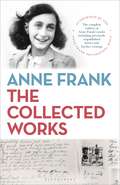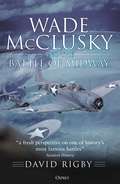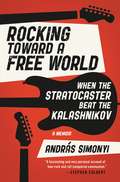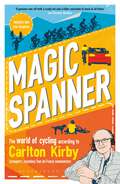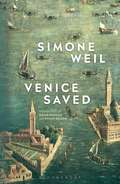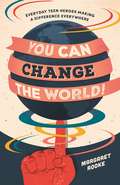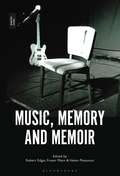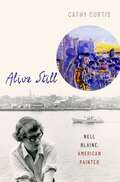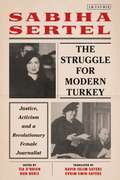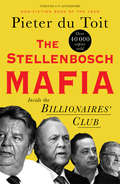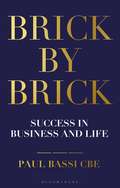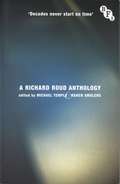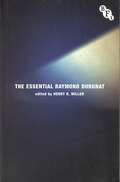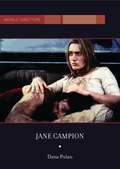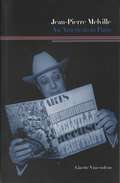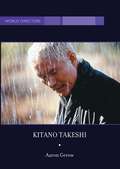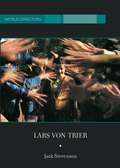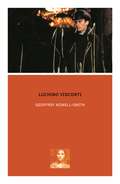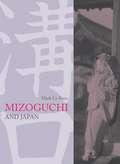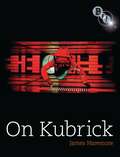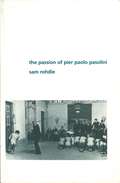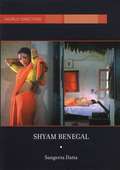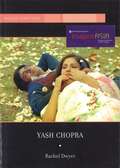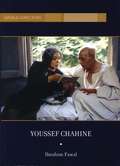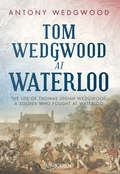- Table View
- List View
Anne Frank: The Collected Works
by Anne Frank FondsAnne Frank's diary is one of the most recognised and widely read books of the Second World War. Hundreds of thousands of people visit the Anne Frank House on the Prinsengracht in Amsterdam each year to see the annexe where Anne and her family hid from the occupying forces, before eventually being deported to Auschwitz in 1944. Only Anne's father, Otto, survived the Holocaust.Anne Frank: The Collected Works includes each of the versions of Anne's world-famous diary including the 'A' and 'B' diaries now in continuous, readable form, and the definitive text ('D') edited by renowned translator and author Mirjam Pressler. For the first time readers have access to Anne's letters, personal reminiscences, daydreams, essays and notebook of favourite quotes. Also included are background essays by notable writers such as historian Gerhard Hirschfeld (University of Stuttgart) and Francine Prose (Bard College) on topics such as 'Anne Frank's Life', 'The History of the Frank Family' and 'The Publication History of Anne Frank's diary', as well as numerous photographs of the Franks and the other occupants of the annexe.An essential book for scholars and general readers alike, The Collected Works brings together for the first time Anne Frank's complete writings, together with important images and documents. Supported by the Anne Frank Fonds in Basel, Switzerland, set up by Otto Frank to act as the guardian of Anne's work, this is a landmark publication marking the anniversary of 90 years since Anne's birth in 1929.
Wade McClusky and the Battle of Midway
by David RigbyDuring the Battle of Midway in June 1942, US Navy dive bomber pilot Wade McClusky proved himself to be one of the greatest pilots and combat leaders in American history, but his story has never been told – until now. It was Wade McClusky who remained calm when the Japanese fleet was not where it was expected to be. It was he who made the counterintuitive choice to then search to the north instead of to the south. It was also McClusky who took the calculated risk of continuing to search even though his bombers were low on fuel and may not have enough to make it back to the Enterprise. His ability to remain calm under enormous pressure played a huge role in the US Navy winning this decisive victory that turned the tide of war in the Pacific. This book is the story of exactly the right man being in exactly the right place at exactly the right time. Wade McClusky was that man and this is his story.
Rocking Toward a Free World: When the Stratocaster Beat the Kalashnikov
by András SimonyiFrom renowned diplomat and musician András Simonyi -- whom Stephen Colbert calls "the only ambassador I know who can shred a mean guitar!" -- comes a timely and revealing memoir about growing up behind the Iron Curtain and longing for freedom while chasing the great power of rock and roll. p.p1 {margin: 0.0px 0.0px 0.0px 0.0px; text-indent: 36.0px; font: 12.0px Arial} In ROCKING TOWARD A FREE WORLD, Simonyi charts the struggle of growing up in 1960s Hungary, a world in which listening to his favorite music was a powerful but furtive endeavor: records were black-market bootlegs; concerts were held under strict control, even banned; protests were folded into song lyrics. Get caught listening to Western radio could mean punishment, maybe prison. That didn't matter to Simonyi, who from an early age felt the tremendous pull of rock and roll, the lure of American popular culture, and a burning desire to buck the system. Inspired by the protest music coming out of the West, he formed a band and became part of Hungary's burgeoning rock scene. Then came the setbacks: tightening of control by the state, the seemingly inescapable weight of an authoritarian system, and the collapse of Simonyi's own dreams of stardom. A story of youth, rebellion, and hope, ROCKING TOWARD A FREE WORLD sheds new light on two of the most powerful forces of the modern age: global democracy and rock and roll. Deeply vital and compelling, Simonyi's memoir chronicles how one man's tremendous connection to American and British popular music inspired him to make a difference in his country and, eventually, the world. It tells the story of a generation, as played out in song lyrics and guitar riffs. p.p1 {margin: 0.0px 0.0px 0.0px 0.0px; font: 13.0px Times} p.p2 {margin: 0.0px 0.0px 0.0px 0.0px; font: 13.0px Times; min-height: 16.0px}
Magic Spanner: The World of Cycling According to Carlton Kirby
by Carlton Kirby Robbie BroughtonPrepare to be entertained as legendary Eurosport cycling commentator Carlton Kirby shares his tales from the road, taking you behind the scenes of the world's greatest cycle races.'A genuine one-off with a ready wit and a killer anecdote to hand at all times' Ian Cleverly, Rouleur'Carlton Kirby is no ordinary cycling commentator, so it is not surprising that this very entertaining book is no ordinary Grand Tour on a bicycle. A very enjoyable journey for everyone' Phil Liggett MBE, NBC Tour de France commentator'Carlton Kirby's infectious enthusiasm, wine tips and Shakespearean joy for inventing words makes every stage of a bike race a must-watch event' Matt Butler, i newspaper With a candid authority that comes from over 25 years commentating on the world's biggest cycling races, legendary Eurosport commentator Carlton Kirby isn't afraid to tell it like it really is. Witty, outrageous and often outspoken, Magic Spanner is an insider's view of life on cycling's Grand Tours, including the Tour de France, Giro D'Italia, Vuelta a España and the classics, all delivered in the inimitable style for which Carlton has become globally famous.Peppered with hilarious anecdotes of life on the road with Tour legend Sean Kelly, Carlton gives us an expert, behind-the-scenes view – one that the average fan rarely gets to see or hear about. As well as sharing his various bugbears (including crazy spectators in mankinis to the more serious issues of rider safety), Carlton also lifts the lid on team strategies, and delves into some of cycling's more questionable ethics.Delivering a mix of expert opinion and trademark wit, Carlton covers the funny, the serious and the more bizarre moments on the professional cycling caravan.
Venice Saved
by Simone WeilTowards the end of her life, the French philosopher and mystic Simone Weil (1909-43) was working on a tragedy, Venice Saved. Appearing here in English for the first time, this play explores the realisation of Weil's own thoughts on tragedy. A figure of affliction, a central theme in Weil's religious metaphysics, the central character offers a unique insight into Weil's broader philosophical interest in truth and justice, and provides a fresh perspective on the wider conception of tragedy itself.The play depicts the plot by a group of Spanish mercenaries to sack Venice in 1618 and how it fails when one conspirator, Jaffier, betrays them to the Venetian authorities, because he feels compassion for the city's beauty. The edition includes notes on the play by the translators as well as introductory material on: the life of Weil; the genesis and purport of the play; Weil and the tragic; the issues raised by translating Venice Saved. With additional suggestions for further reading, the volume opens up an area of interest and research: the literary Weil.
You Can Change the World!: Everyday Teen Heroes Making a Difference Everywhere
by Margaret RookeThis inspirational book tells the stories of more than 50 of today's teenagers who've dared to change the world they live in. It's been written to show other teens they can do the same.Bestselling author Margaret Rooke asks teens about their experiences of being volunteers, social entrepreneurs and campaigners, online and beyond. They explain how they have survived in a world often obsessed by celebrity, social media and appearance, by refusing to conform to other's expectations. If you want to achieve against the odds and create genuine impact, this book may be the encouragement you need.The interviews cover race, sexuality, violence, grief, neurodiversity, bullying and other issues central to life today.Read about teens from around the world includingTrisha, 18, who has invented a way of preventing bullying onlineDillon, 18, who takes damaged and donated clothing and upcycles it for the homeless Guro, 13, who persuaded a pop band to portray women differently in its video'Happy D', 19, who learned to read at 14 and found ways to build his confidenceHeraa, 19, who fights Islamophobia online.Ruben, 18, bullied because of Down's Syndrome, now a successful actorLucy who, at 14, walked into Tesco head office and persuaded them not to sell eggs from caged hens.Cameron, 17, who has cerebral palsy and was side-lined by soccer teams who set up his own team 'Adversity United'Alex, 18, who broke his back on his 15th birthday and says his injury has taught him to care for othersAmika, 18, who fights 'Period Poverty'Jesse, 15, who's seven feet tall and embraces his statureBilly, 18, who wore full make up every day at high schoolAnd many more
Music, Memory and Memoir
by Robert Edgar Fraser Mann Helen PleasanceMusic, Memory and Memoir provides a unique look at the contemporary cultural phenomenon of the music memoir and, leading from this, the way that music is used to construct memory. Via analyses of memoirs that consider punk and pop, indie and dance, this text examines the nature of memory for musicians and the function of music in creating personal and cultural narratives. This book includes innovative and multidisciplinary approaches from a range of contributors consisting of academics, critics and musicians, evaluating this phenomenon from multiple academic and creative practices, and examines the contemporary music memoir in its cultural and literary contexts.
Alive Still: Nell Blaine, American Painter
by Cathy CurtisAmong the women artists who came to prominence in the postwar era in New York, painter Nell Blaine had a uniquely hard-won career. In her mid-thirties, her horizons seemed limitless. Her shows received glowing reviews, ARTnews honored her with a lengthy feature article, and one of her paintings hung in the Whitney Museum. Then, on a trip to Greece, Blaine developed polio, rendering her a paraplegic. Angry at being told she would never paint again, she taught herself to hold a brush with her left hand and regained her skill. In Alive Still, author Cathy Curtis tells the story of Blaine's life and career for the first time by investigating the ways her experience of illness colored her personality and the evolving nature of her work, the importance of her Southern roots, and the influence of her bisexuality (and, in the latter part of her life, long term lesbian relationships) on her understanding of the world. Alive Still draws upon Blaine's unpublished diaries; her published writing; career-spanning interviews and reviews; and correspondence to and from family members, lovers, and the artists, poets, publishers, rescuers in Greece, and neighbors she knew. In addition, Curtis has conducted interviews with surviving artists and other individuals in Blaine's circle, including two of her longtime lovers. Featuring illustrations of Blaine's work and snapshots of family and friends, Alive Still is a compelling narrative of a leading, productive, and passionate woman artist who overcame the setbacks of disability.
The Struggle for Modern Turkey: Justice, Activism and a Revolutionary Female Journalist
by Sabiha SertelSabiha Sertel was born into revolution in 1895, as an independent Turkey rose out of the dying Ottoman Empire. The nation's first professional female journalist, her unrelenting push for democracy and social reforms ultimately cost Sertel her country and freedom.Shortly before her death in 1968, Sertel completed her autobiography Roman Gibi (Like a Novel), which was written during her forced exile in the Soviet Union. Translated here into English for the first time, and complete with a new introduction and comprehensive annotations, it offers a rare perspective on Turkey's history as it moved to embrace democracy, then violently recoiled. The book reveals the voice of a passionate feminist and committed socialist who clashes with the young republic's leadership. A unique first-hand account, the text foreshadows Turkey's increasingly authoritarian state. Sertel offers her perspective on the fierce divisions over the republic's constitution and covers issues including freedom of the press, women's civil rights and the pre-WWII discussions with European leaders about Hitler's rising power.
The Stellenbosch Mafia: Inside the Billionaire’s Club
by Pieter du ToitAbout 50km outside of Cape Town lies the beautiful town of Stellenbosch, nestled against vineyards and blue mountains that stretch to the sky. Here reside some of South Africa’s wealthiest individuals: all male, all Afrikaans – and all stinking rich. Johann Rupert, Jannie Mouton, Markus Jooste and Christo Weise, to name a few.Julius Malema refers to them scathingly as ‘The Stellenbosch Mafia’, the very worst example of white monopoly capital. But who really are these mega-wealthy individuals, and what influence do they exert not only on Stellenbosch but more broadly on South African society?Author Pieter du Toit begins by exploring the roots of Stellenbosch, one of the wealthiest towns in South Africa and arguably the cradle of Afrikanerdom. This is the birthplace of apartheid leaders, intellectuals, newspaper empires and more.He then closely examines this ‘club’ of billionaires. Who are they and, crucially, how are they connected? What network of boardroom membership, alliances and family connections exist? Who are the ‘old guard’ and who are the ‘inkommers’, and what about the youngsters desperate to make their mark? He looks at the collapse of Steinhoff: what went wrong, and whether there are other companies at risk of a similar fate. He examines the control these men have over cultural life, including pulling the strings in South Africa rugby.
Brick by Brick: Success in Business and Life
by Paul BassiSuccess is a simple thing that most people believe to be something mysterious and complicated - the reality, according to Paul Bassi, is something completely different. In the vast majority of cases, the people at the top have got there by following disciplines that open to everyone. The truth about success is that it's closer than you might think but harder work than you expect.Anyone can be successful in life - by your own definition, which is the only one that really matters - if you set yourself a central ambition and follow some fundamental principles about how it can be achieved. While the advice in this book may look primarily at business and property, the underlying themes are applicable to whatever life and career you wish to pursue.Drawing on stories from his youth, early career, family life and his current position as one of the Midlands' most prominent property investors, Paul Bassi shows how you can plan your own journey to success. It won't be easy; it won't happen overnight; and it won't come without making sacrifices. But if you want it badly enough and are prepared to be disciplined and relentless in your approach, it is all perfectly possible. This book will show you exactly what it takes.
Decades Never Start on Time: A Richard Roud Anthology
Richard Roud, film writer and co-founder and director of the New York Film Festival, was one of the most influential film critics of the twentieth century. Renowned for his close relationships with French New Wave directors such as Godard and Truffaut, he played a key role in bringing European art cinema to the attention of American and British audiences.This anthology brings together selected writings from his published works with previously unpublished archival material – from an unfinished study of Truffaut, to extracts from his books on film-makers such as Straub-Huillet and Ophüls, and articles for The Guardian and Sight & Sound. Charting Roud's journey through the world of film festivals and film criticism from the 1950s to the 1980s, Decades Never Start on Time provides a fascinating insight into the flourishing film culture of the era.With a preface by David Thomson.
The Essential Raymond Durgnat
Raymond durgnat was a maverick voice during the golden age of film criticism. From the French new Wave and the rise of auteurism, through the late 1960s counter-culture, to the rejuvenated Hollywood of the 1970s, his work appeared in dozens of publications in Britain, France and the USA. At once evoking the film culture of his own times and anticipating our digital age in which technology allows everyone to create their own 'moving image-text combos', durgnat's writings touch on crucial questions in film criticism that resonate more than ever today. Bringing together durgnat's essential writing for the very first time, this career-spanning collection includes previously unpublished and untranslated work and is thoroughly introduced and annotated by Henry K. Miller.
Jane Campion (World Directors)
by Dana PolanWith the phenomenal success of 'The Piano' (1993), Jane Campion became revered by many as the leading female film director of the 1990s. In this book, Dana Polan examines the phenomenon of 'The Piano' and how it develops from the early shorts and first features which evoke an often surreal and critical distanced style of looking at everyday issues. Looking at all of Campion's work before and since, including 'Holy Smoke' (1999), which returned again to the battleground of gender politics, the author concludes his survey of the director's work by offering some hypotheses about the erotic thriller 'The Cut' (2001) whilst asking what variety of approaches to the study of directors might now be fruitful.
Jean-Pierre Melville: An American in Paris
by Ginette VincendeauGinette Vincendeau discusses the artistic value of his films in their proper context and comments on Jean-Pierre Melville's love of American culture and his controversial critical and political standing in this English language study.
Kitano Takeshi (World Directors)
by Aaron GerowCombining a detailed account of the situation in Japanese film and criticism with unique close analyses of Kitano's films from Violent Cop to Takeshis, the author relates the director to issues of contemporary cinema, Japanese national identity, and globalism.
Lars Von Trier (World Directors)
by Jack StevensonWith the international success of Breaking the Waves (1996) and Dancer in the Dark (2000), Lars von Trier has established himself as a one of the most provocative and daring film directors working today. The founding father of Dogma 95, he made the movement's most controversial film, The Idiots (1998), and has played a leading role in the recent resurgence of Danish cinema. Yet despite his success, von Trier remains something of an polarising and enigmatic figure hailed as the new Godard by some and a charlatan by others. In this new study, Jack Stevenson explores the achievements as well as the paradoxes of Lars von Trier, assessing his life, work, and critical reception. The book follows von Trier from his early life as a troubled son of 'Cultural Radical' parents through to his student days at the Danish Film School, diligently spent making films that were as innovative and disturbing as his later features have proved to be. These films (consisting of the Europa and Gold-Hearted trilogies) are fully examined together with considerations of his creative detours into other media and his current work in progress, Dogville. Based in Denmark, the author brings a unique perspective to Lars von Trier creating a multi-dimensional portrait of the director. Utilising sources heretofore unavailable in English, Stevenson's lively yet fact-filled narrative is accessible to students and film enthusiasts alike. The book is indispensable to anyone interested in Lars von Trier and the broader issues that surround modern Danish film and its current renaissance.
Luchino Visconti
by Geoffrey Nowell-SmithAristocrat and Marxist, master equally of harsh realism and sublime melodrama, Luchino Visconti (1906-1976) was without question one of the greatest European film directors. His career as a film-maker began in the 1930s when he escaped the stifling culture of Fascist Italy to work with Jean Renoir in the France of the Popular Front. Back in his native country in the 40s he was one of the founders of the neo-realist movement. In 1954, with Senso, he turned his hand to a historical spectacular. The result was both glorious to look at and a profound reinterpretation of history. In Rocco and His Brothers (1960) he returned to his neo-realist roots and in The Leopard (1963), with Burt Lancaster, Claudia Cardinale and Alain Delon, he made the first truly international film. He scored a further success with Death in Venice (1971), a sensitive adaptation of Thomas Mann's story about a writer (in the film, a musician) whose world is devastated when he falls in love with a young boy. A similar homo-erotic theme haunts Ludwig (1973), a bio-pic about the King of Bavaria who prefers art to politics and the company of stableboys to the princess he is supposed to marry. Geoffrey Nowell-Smith's classic study of the director was first published in 1967 and revised in 1973. It is now updated to include the last three films that Visconti made before his death, together with some reflections on the 'auteur' theory of which the original edition was a key example.
Mizoguchi and Japan
by Mark Le FanuFor a majority of film-goers, the names most usually associated with classic Japanese cinema are those of Kurosawa and Ozu. Yet during the early 1950s, at the same time that Kurosawa was becoming known to the public through the release of classics like Rashomon and The Seven Samurai, another Japanese director, Kenji Mizoguchi, quietly came out with a trilogy of films-The Life of Oharu, Ugetsu Monogatari and Sansho the Bailiff-that are the equal of Kurosawa's in mastery, and which by any account rank among the greatest and most enduring masterpieces of world cinema. As a storyteller, Mizoguchi was drawn to the plight and oppression of women throughout the ages- it was, for him, the 'subject of subjects'. So in addition to the movies just mentioned, he is remembered for a string of masterly contemporary films that examined, with unprecedented candour and ferocity, the conditions of life in Japanese brothels and geisha houses. Yet, as well as being a moralist. Mizoguchi was a stylist. His films are considered by critics to be among the most beautiful ever made, from a purely pictorial point of view. Filmgoers who have responded enthuslastically in recent years to Chinese classics like Farewell My Concubine or to the colourful works of Zhang Yimou will be delighted to discover 'pre-echoes' of this cinema in such late films by this Japanese master as The Empress Yang Kwei Fei and Tales of the Taira Clan (both released in 1955) works in which Despite his extraordinary qualities as a film-maker, Mizoguchi and Japan is the first full -length study in English for over 20 years of a director whose work is as vibrant now as it ever was in its heyday, and whom the French film review Cahiers du Cinema recently hailed 'the greatest of all cineastes.'
On Kubrick
by James NaremoreOn Kubrick provides an illuminating critical account of the films of Stanley Kubrick, from his earliest feature, Fear and Desire (1953), to the posthumously-produced A.I. Artificial Intelligence (Steven Spielberg, 2001). The book offers provocative analysis of each of Kubrick's films, together with new information about their production histories and cultural contexts. Its ultimate aim is to provide a concise yet thorough discussion that will be useful as both an academic text and a trade publication. James Naremore argues that in several respects Kubrick was one of the cinema's last modernists: his taste and sensibility were shaped by the artistic culture of New York in the 1950s; he became a celebrated auteur who forged a distinctive style; he used art-cinema conventions in commercial productions; he challenged censorship regulations; and throughout his career he was preoccupied with one of the central themes of modernist art – the conflict between rationality and its ever-present shadow, the unconscious. War and science are key concerns in Kubrick's oeuvre, and his work has a hyper-masculine quality. Yet no director has more relentlessly emphasized the absurdity of combat, as in Paths of Glory (1957) and Full Metal Jacket (1987), the failure of scientific reasoning, as in 2001 (1968), and the fascistic impulses in masculine sexuality, as in Dr Strangelove (1964) and Eyes Wide Shut (1999). The book also argues that while Kubrick was a voracious intellectual and a life-long autodidact, the fascination of his work has less to do with the ideas it espouses than with the emotions it evokes. Often described as 'cool' or 'cold,' Kubrick is best understood as a skillful practitioner of what might be called the aesthetics of the grotesque; he employs extreme forms of caricature and black comedy to create disgusting, frightening yet also laughable images of the human body, creating a sense of unease that leaves viewers unsure of how to react.
The Passion of Pier Paolo Pasolini
by Sam RohdieThis is a personal account of Pier Paolo Pasolini's cinema and literature, written by the author of 'Antonioni' and 'Rocco and his Brothers'.
Shyam Benegal (World Directors)
by Sangeeta DattaShyam Benegal is the best known and most prolific contemporary film-maker from India's arthouse or 'New Cinema' tradition. This work traces a career with its beginnings in political cinema and a realist aesthetic. Sangeeta Datta demonstrates how the struggles of women and the dispossessed and marginalised in Indian society have found an eloquent expression in films as diverse as Nishant, Bhumika, Mandi, Suraj Ka Satwan Ghoda and Kalyug. The book also traces Benegal's work with his protégés and collaborators including many of the biggest names in Indian Cinema - Shabana Azmi, Smita Patil, Naseeruddin Shah, Karishma Kapoor and A.R. Rahman.
Yash Chopra (World Directors)
by Rachel DwyerAs a charismatic director in the Indian film industry, Chopra's name is synonymous with the glamour of the romantic film and a certain style within Indian culture. Spanning four decades, his directed features include some of the classic films of Indian film history, such as 'Deewaar' and 'Kabhi Kabhie'. His directorial career began in 1959 with 'Dhool Ka Phool' and he has been a major producer since 1973, consolidating his success in the 1990s with a series of huge box office hits including 'Dilwale Dulhaniya Le Jayenge'. He has also worked in other Hindi movie genres, directing action movies such as 'Mashaal' and a thriller, 'Darr'. This book discusses in depth his work with the Hindi megastar Amitabh Bachanan in films such as 'Deewaar', 'Trishul', 'Kala Patthar' and 'Silsila' and how, in his transformation of the look of mainstream cinema in 'Dil To Pagal Hai' and other films, Yash Chopra has proved to be a tireless innovator within a mainstream tradition. The author integrates this analysis with information about the man and his work, based on interviews with Yash Chopra, his family, his colleagues, his stars, his contemporaries and major critics that include views from Amitabh Bachchan, Shahrukh Khan, Shashi Kapoor and Sri Devi. A study of a top contemporary Indian film director, Rachel Dwyer's book also examines the influence on Chopra of predecessors such as Raj Kapoor and how his own legacy can be seen in such films as 'Kuch Kuch Hota Hai' and younger directors such as Karan Johar and Aditya Chopra.
Youssef Chahine (World Directors)
by Ibrahim FawalA discussion of the frequently controversial film maker Youssef Chahine. The book aims to illuminate Chahine's work in the context of modern Egyptian culture and its tumultuous post-war history and how such films as 'Cairo Station' (1958), 'The Earth' (1959) and 'The Sparrow' (1973) dramatized the dilemmas of ordinary Egyptians. He also argues that Chahine's intensely autobiographical trilogy 'Alexandria...Why?' (1978), 'An Egyptian Story' (1985) and 'Alexandria...More and More' (1989) spoke to the concerns of the broader Egyptian intelligentsia amongst whom he has earned the reputation of being the 'poet and thinker' of modern Arab cinema. The final analysis of the book argues that Chahine's work stands comparison with directors such as Fellini, Bergman, Kurosawa or Sembene but also emphatically draws strength from its links with one of the most vibrant popular cinemas of the world and from the roots and traditions of popular Arabic culture.
Tom Wedgwood at Waterloo: The Life of Thomas Josiah Wedgwood who Fought at Waterloo
by Antony WedgwoodThomas ‘Tom’ Josiah Wedgwood (1797–1860) was the grandson of the English potter and entrepreneur Josiah Wedgwood, and the son of John Wedgwood and Louisa Jane (Jenny) Allen.Tom was a professional soldier, gazetted Ensign in the 3rd Foot Guards at the age of sixteen. Less than eighteen months later he was sent to fight at Waterloo and took part in the crucial defence of Hougoumont. He was promoted to Captain in 1820 and participated in a rather neglected ‘peace keeping’ operation in Portugal, from 1827 to 1828. Later in 1830 he was promoted to Lieutenant Colonel and continued serving in the army until 1837.In later life, Tom married and settled in Tenby where he became a respected citizen; a memorial fountain in his honour still exists in that town. A number of Tom’s letters from the Waterloo campaign have survived as has a detailed journal that he kept during his time in Portugal; these documents, many previously unpublished, form the core of this book.
